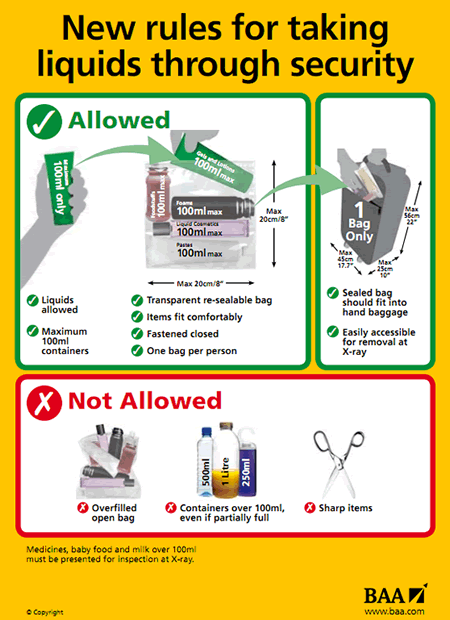A nitrogen-free explosive
Monday 9 March 2015
Have you ever wonder exactly why airlines are so wary of passengers carrying more than 100 cm3 of liquids on board airplanes?

Poster produced by the British Airports Authority ©
The liquid they are most concerned about is hydrogen peroxide. When this is mixed with propanone in the presence of a strong acid, such as sulfuric or hydrochloric acid, it forms propanone peroxide, which is potentially explosive. It is one of the few simple explosives that does not contain a nitrogen atom and so is less easy to detect by scanners looking for nitrogenous substances at airports.
I did my Ph.D. at the University of Manchester in the UK and worked with hydroperoxides (ROOH) synthesising new organometallic compounds involving organic peroxides. There was always the risk of an explosion so I was interested and concerned to read in the press that last week the emergency services were called to Manchester University to deal with the possibility of an explosion. This was because a student had accidently synthesised a crystalline form of propanone peroxide. Coincidentally it was just hours after another chemistry student had been injured and required evacuation after an accident at the University of Liverpool which is also in the north of England.
If you put ‘propanone peroxide’ into a search engine what in fact will come up is ‘acetone peroxide’. This is a good example of how the language we use in IB chemistry, although technically correct according to IUPAC, is not the language used by almost everyone else.
As the video below shows, acetone peroxide is relatively easy to make but should NEVER be done by students or teachers, as the probability of an accident is very high.
The actual substance ‘acetone peroxide’ is in reality a trimer, triacetone triperoxide, also known as TCAP.

The kinetics of this synthetic reaction has been studied by J. C. Oxley, J. L. Smith, L. Steinkamp and G. Zhang.

Although the proposed mechanism is beyond IB chemistry, some of the steps are instantly recognisable and you could use it to test your students. For example, the very first step involves nucleophilic addition of hydrogen peroxide to propanone. The carbon atom in the carbonyl group has a small positive charge (δ+) due to the electronegative oxygen atom. The hydrogen peroxide acts as a nucleophile due to one of the non-bonding pairs of electrons on one of the oxygen atoms and the role of the mineral acid is to act as a catalyst by protonating the carbonyl oxygen atom.

